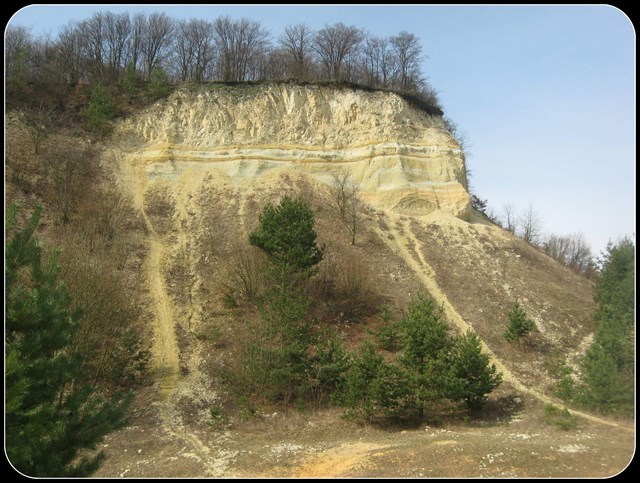Tato keš vás zavede na místo, kterému se dříve přezdívalo Moravský Říp a bylo zde haltštatské hradiště. Ve východní části svědeckého vrchu se nachází bývalý lom, který je krajinnou dominantou jižní části Boskovicka.
This cache led you to a place formerly called Moravian Rip, and inhabited settlements in Halstat. On the eastern wall of the witnessing hill, which is the landscape of the southern part of Boskovicko, there is a former quarry.

/ CZ /
Geologie
Geologická charakteristika: Na lokalitě jsou starým lomem odkryty sedimenty svrchní křídy, které jsou zachovány v depresní tektonické struktuře blanenského prolomu a v současnosti vytvářejí denudační relikty v podobě svědeckých vrchů. Křídové horniny zde leží na permských sedimentech boskovické brázdy. Křídový sled začíná perucko-korycanským souvrstvím (stupeň cenoman), jehož spodní část náleží peruckým vrstvám. Ty jsou zastoupeny křemitými pískovci až slepenci s polohami jílovců, doprovázenými uhelnými slojkami. Jílovce a uhelné sloje byly v minulosti objektem těžby, na jejíž pozůstatky, v podobě haldiček tmavých jílovců, můžeme v bezprostředním okolí narazit (např.při zelené turistické stezce pod vrchem Velký Chlum, nedaleko sousoší husitských bojovníků, vytesaných v peruckých pískovcích).
Přímo na lokalitě Malý Chlum jsou v nejspodnější části lomu odkryty hrubozrnné křemenné pískovce, které jsou místně silně železité. V jejich nadložích spočívají středně zrnité glaukonitické pískovce, které tvoří spodní polovinu odkryté lomové stěny a náleží již ke korycanským vrstvám, které se usadily v mořském prostředí. Na korycanské pískovce ostře nasedají horniny bělohorského souvrství, které jsou zastoupeny vápnitými spongolitickými prachovci a pískovci, obecně označovanými jako opuky. Nejčastěji se vyskytují misky inoceramidních mlžů (podle rodu Inoceramus), kteří jsou charakterističtí pro křídu a představují vůdčí fosilie. Výskyt druhu Inoceramus labiatus dokládá raně turonské stáří hornin bělohorského souvrství, odkrytých zde v lomu.
Kromě inoceramidů a jiných skupin mlžů se zde vyskytují např. ježovky, případně širomořští amoniti. Těsně pod vrcholem Malého Chlumu, 20 m jihovýchodně od rozhledny, jsou odkryty vyšší partie bělohorského souvrství, zastoupené vápnitými spongolitickými pískovci s glaukonitem, které jsou silicifikované.

Pro uznání logu prosím navštivte místo, získejte informace a přes můj profil zasílejte své odpovědi na mou e-mailovou adresu. Nezapomeňte připojit svůj nick! V případě nejasností Vás budu kontaktovat.
Otázky a úkoly
1 / a Na úvodních souřadnicích zjistěte pomocí svých přístrojů v jaké nadmořské výšce se nacházíte.
1 / b Které horniny se zde nacházejí?
2 / a Na stage 2 se nacházíte u pískovcové stěny. Vysvětlete vlastními slovy, jaké zabarvení pískovec má a proč?
2 / b Vyfoťte (nepovinné) sebe nebo své GPS přístroje u pískovcové stěny na stage 2.
3 / a Na koryčanských pískovcích ostře nasedají rohy bělohorského souvrství, zastoupené vápennými spongolitickými prachovci a pískovci, obecně označenými jako opuky. Jakou maji tyto horniny barvu a co obsahují?
/ EN /
Geology
Geological characteristics: At this point, the sediments of the upper chalk are exposed by an old quarry, preserved in the depressive tectonic structure of the Blanský zlom and presently create denudatory monuments in the form of witnesses. Cretaceous rocks are located in the Permian sediments in the Boskovice wilderness. The sequence of the chalk begins with the Peruvian-Korycan group (cenomanian degree), the lower part of which belongs to percussion layers. They are composed of quartz sandstones and adhesives with clay positions, accompanied by carbon threads. Claystone and coal strings were previously mined, the remains of which in the form of a dark claystone dumbbell can be found in the immediate vicinity of the locality (eg on a green hiking trail below Velký Chlum hill, near the sculpture of the Hussite warriors carved in Peruvian sandstones). Directly in the locality of Malý Chlum are exposed in the lower part of the quarry coarse-grained quartz sandstone, which is sometimes strongly ironic. Overheating them is the medium-grained glauktonic sandstone, which forms the lower half of the fracture fractures and belongs to the layers of Koryčany, which settled in the marine environment. The rock formations of the White Mountains sharply cling to Koryčany sandstone, which are represented by limestone spongolitic dusts and sandstone, which are commonly referred to as opposites. The most common inoceramides (Inoceramus), which are characterized by chalk and are the leading fossils. The incidence of Inoceramus labiatus illustrates the early Turonian age of the rocks of white mountain formations, which were exposed here in the quarry. In addition to inoceramides and other bivalve groups, these are, for example, the Summers umbilicals or amorphites. Just below the summit of Malý Chlum, 20 m southeast of the tower, is revealed a higher part of the White Mountains, represented by calcium spongolytic sandstone with glauconite, which are silicified.
To recognize the log please visit the place, get the information and send your replies to my email address via my profile.
Questions and Answers
1 / a Find out at Infoboard from your GPS at what altitude you are at.
1 / b Which rocks are there and what have they been doing for years?
2 / a On stage 2 you are at the sandstone wall. Explain in your own words what color sandstone has and why.
2 / b Take a picture of yourself or your GPS with the sandstone wall on stage 2 and write what weather you have reached on the spot.
3 / a On the Koryčany sandstones, the horns of the White Mountain formations, shrouded with lime spongolitic dustbins and sandstones, generally labeled as opuques, are sharply mounted. What are the rocks and what do they contain?

Zdroj: http://lokality.geology.cz/